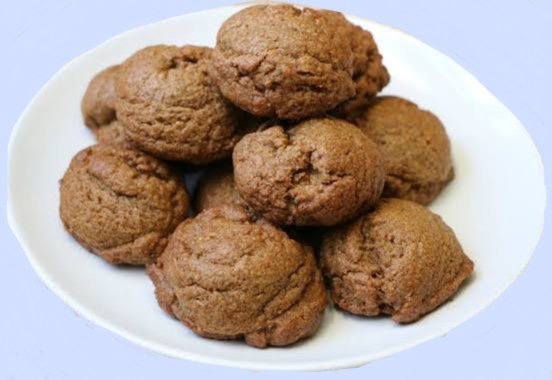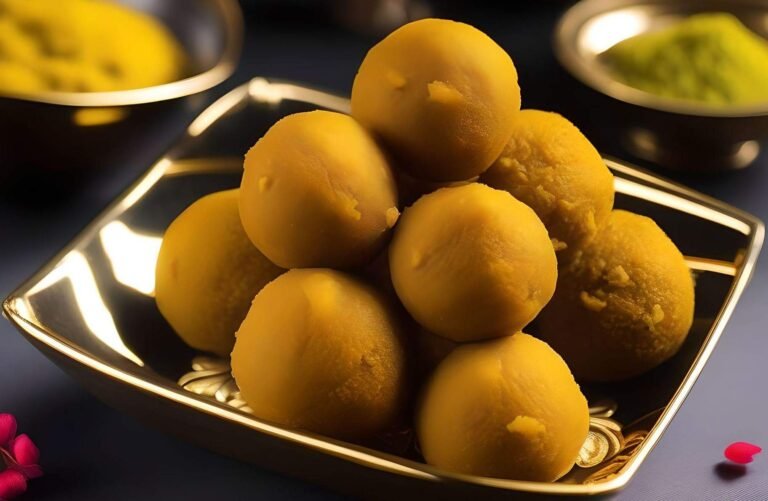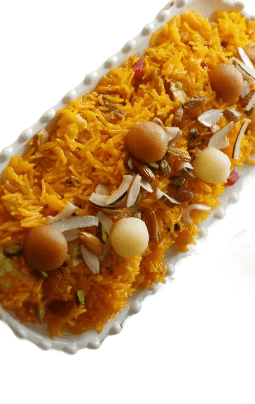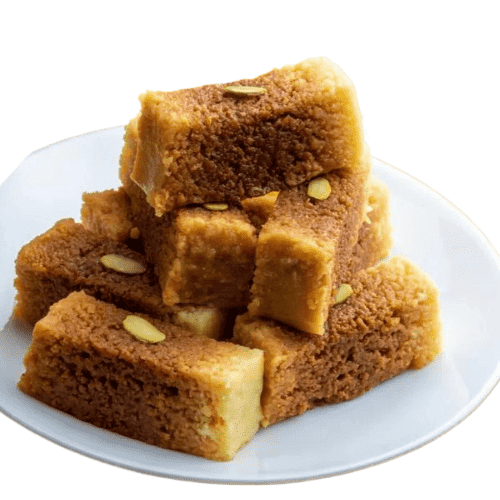Modak
Introduction :
Modak, a sweet dumpling delicacy cherished in India, particularly in Maharashtra, is a divine treat often associated with the Hindu deity Lord Ganesha. Revered as one of His favorite foods, Modak is not just a dessert but a symbol of devotion, celebration, and tradition. In this article, we will explore the history, cultural significance, varieties, and step-by-step recipes of Modak, helping you bring this delightful sweet into your home kitchen.
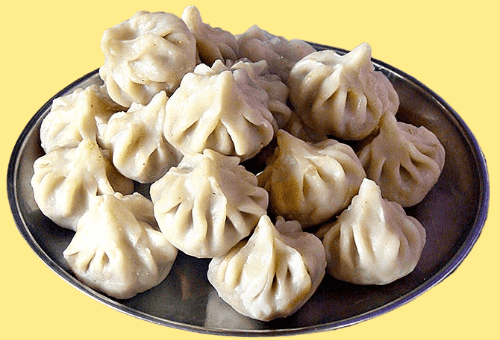
The History and Cultural Significance :
Modak has deep roots in Indian culture, especially within Hindu rituals and festivities. This delicacy is an integral part of the Ganesh Chaturthi celebrations, an 11-day festival celebrated with great enthusiasm in Maharashtra and other parts of India. According to Hindu mythology, Modak is considered the most beloved sweet of Lord Ganesha, who is often depicted holding or consuming this delightful treat.
Mythological Connection :
The origins of Modak are steeped in mythological stories. One popular legend suggests that Modak symbolizes prosperity, wisdom, and inner bliss. The outer layer of the Modak represents the challenges one faces in life, while the sweet filling inside symbolizes the spiritual joy that lies within.
Another story revolves around Lord Shiva, Parvati, and their sons, Ganesha and Kartikeya. When the brothers were challenged to go around the world, Kartikeya set off on a journey around the globe. Ganesha, however, circled his parents, considering them his entire world, thus winning the challenge. To reward Ganesha, Parvati offered him a Modak, signifying the reward for his wisdom and understanding.
Regional Significance :
While Modak is most popular in Maharashtra, it also finds a place in other regional cuisines, albeit with different names and variations. In South India, it is known as Kozhukattai; in Goa, it is called Ukadiche Modak, while in West Bengal, a similar sweet called Pithe is enjoyed during festivals.
Different Types of Modak :
The traditional steamed Modak, known as Ukadiche Modak, is the most popular variety. However, several other types have emerged over time, catering to varied tastes and preferences. Here are some of the most loving varieties :
Ukadiche Modak (Steamed Modak) :
Ukadiche Modak is the classic version, where the dumplings are steamed and filled with coconut, jaggery, and nuts. The soft, thin rice flour shell encases the sweet filling, making it a melt-in-your-mouth delicacy.
Fried Modak :
Fried Modak offers a crunchy alternative to the steamed version. It has a golden-brown, crispy outer layer, and the sweet filling inside remains the same. These Modaks are usually prepared as a special treat during festivals or offered as prasad.
Chocolate Modak :
A modern twist on the traditional Modak, Chocolate Modak is loved by kids and adults alike. These Modaks blend traditional fillings with chocolate, making them an exciting fusion of Indian and Western flavors.
Mawa Modak (Khoya Modak) :
Mawa Modak is rich, creamy, and decadent. It’s made using khoya (reduced milk solids), sugar, and cardamom, which are shaped into small Modaks. This version does not require steaming or frying and is perfect for those who prefer a rich, milky flavor.
Dry Fruit Modak :
This variety is packed with the goodness of dry fruits and nuts. The filling is made from chopped almonds, cashews, raisins, and pistachios, sweetened with jaggery or sugar. Dry Fruit Modaks are a healthy alternative, rich in nutrients and flavor.
Paneer Modak :
Paneer Modak is a unique variety that combines fresh paneer (Indian cottage cheese) with traditional ingredients. It’s soft, mildly sweet, and offers a distinctive texture compared to other types.
Fusion Modak Varieties :
Creative chefs have taken Modak to new heights by introducing flavors like saffron, rose, mango, and even savory options with spicy fillings. Fusion Modaks are an excellent way to cater to evolving taste buds and contemporary dessert trends.
Ingredients Used in Modak :
Modak’s ingredients are simple but contribute significantly to the taste and texture of this delicacy. Here’s a closer look at the primary ingredients used in various Modak recipes:
Rice Flour :
Rice flour is the key ingredient in the traditional Ukadiche Modak. It provides the outer shell, which is soft, smooth, and slightly chewy. A fine quality rice flour is essential to achieve the right texture.
Coconut :
Grated coconut is commonly used in the filling of Modak. It adds a natural sweetness, texture, and a delightful aroma to the filling.
Jaggery :
Jaggery, a traditional unrefined sugar made from sugarcane or palm sap, sweetens the filling. It has a rich, caramel-like flavor that complements the coconut perfectly.
Khoya (Mawa) :
Used primarily in Mawa Modak, khoya gives the dessert a rich, creamy texture. It’s made by reducing milk until it solidifies, adding a luscious taste to the Modak.
Dry Fruits and Nuts :
Dry fruits and nuts are often added to enhance the flavor and texture. Almonds, cashews, raisins, and pistachios are commonly used, providing crunch and nutritional benefits.
Spices:
Spices like cardamom, saffron, and nutmeg are used to add warmth and a burst of flavor to Modak. These spices are especially prominent in Mawa and Dry Fruit Modaks.
Step-by-Step Recipes of Different Modaks
Traditional Ukadiche Modak (Steamed Modak) :
Ingredients:
- 1 cup rice flour
- 1 cup water
- A pinch of salt
- 1 tsp ghee (clarified butter)
For the filling:
- 1 cup grated coconut
- 1 cup jaggery, grated
- 1/2 tsp cardamom powder
- 1 tbsp poppy seeds (optional)
- 1 tbsp chopped nuts (cashews, almonds)
Instructions:
- Prepare the Filling: Heat a pan and add grated coconut and jaggery. Cook on moo warm until the jaggery softens and mixes with the coconut. Include rice flour continuously, mixing ceaselessly to maintain a strategic distance from knots. Mix well and let it cool.
- Prepare the Dough: Boil water with a pinch of salt and ghee. Add rice flour gradually, stirring continuously to avoid lumps. Cover and let it steam for a minute. Remove from heat and knead into a smooth, soft dough.
- Shape the Modak: Take a small portion of the dough, roll it into a ball, and flatten it to form a cup shape. Place a spoonful of the filling inside and carefully bring the edges together, pinching them to form a conical top.
- Steam the Modaks: Place the Modaks on a greased steamer tray and steam for 10-12 minutes or until the Modaks become shiny and translucent.
- Serve Hot: Serve the Modaks hot with a drizzle of ghee.
Fried Modak :
Ingredients:
- 1 cup all-purpose flour (maida)
- 2 tbsp ghee
- Water, as needed
- Oil for deep frying
For the filling:
Same filling as Ukadiche Modak
Instructions:
- Prepare the Dough: Combine flour, ghee, and water to make a firm dough. Rest it for 20 minutes.
- Shape the Modak: Roll out small balls of dough, fill them with the coconut-jaggery mixture, and shape them into Modaks.
- Fry the Modaks: Heat oil in a deep pan and fry the Modaks until golden brown. Drain on paper towels and serve.
Chocolate Modak :
Ingredients:
- 1 cup grated coconut
- 1/2 cup condensed milk
- 2 tbsp cocoa powder
- 1 tsp ghee
Instructions:
- Prepare the Mixture: Heat a pan, add ghee, and sauté the coconut. Add condensed milk and cocoa powder. Mix well until it thickens.
- Shape the Modaks: Let the mixture cool slightly, then shape it into Modaks using a mold.
Mawa Modak :
Ingredients:
- 1 cup khoya (mawa)
- 1/2 cup powdered sugar
- 1/2 tsp cardamom powder
Instructions:
- Cook the Khoya: Heat khoya in a pan and cook until it softens. Add powdered sugar and cardamom.
- Shape the Modaks: Once the mixture cools slightly, shape it into Modaks using molds.
Tips for Making Perfect Modaks :
- Knead the Dough Well: The dough should be smooth and pliable to avoid cracks while shaping the Modak.
- Maintain Consistency: Ensure the coconut-jaggery filling is not too moist, as this could make the Modak soggy.
- Grease the Mold: If using a mold, always grease it lightly with ghee to prevent sticking.
- Steam Correctly: Steaming time is crucial; over-steaming can make the Modak tough, while under-steaming may leave it raw.
Serving Suggestions and Storage Tips :
Serve Modaks warm, drizzled with ghee. They pair well with warm milk, chai, or simply on their own. Modaks are best consumed fresh, but they can be stored in an airtight container for up to 2 days. Fried Modaks have a slightly longer shelf life and can be kept for up to 4 days.
Read More : Falari Aloo Ki Kadhi
Conclusion :
Modak is more than just a dessert; it’s a celebration of tradition, love, and devotion. Whether you enjoy the traditional Ukadiche Modak or experiment with modern variations like chocolate and dry fruit, the joy of making and sharing Modaks is unparalleled. Embrace this delightful treat in your festivities, and let the sweet, fragrant aroma of Modak fill your home with happiness and prosperity.
